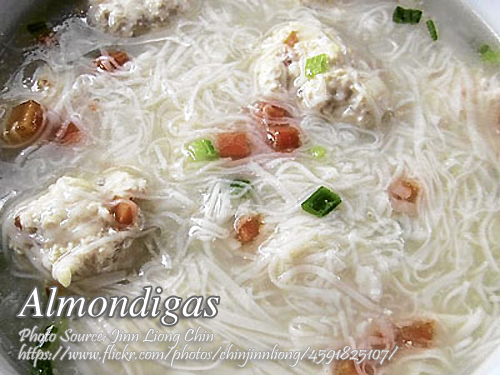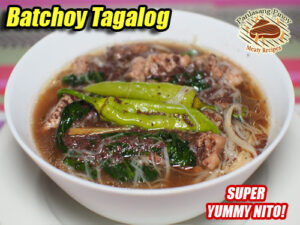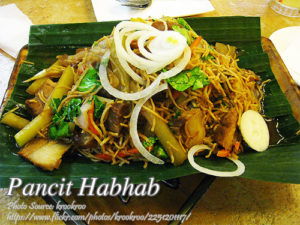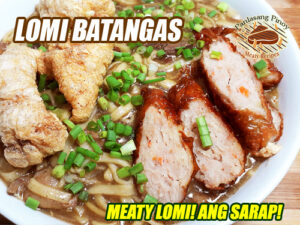Almondigas is an old Filipino soup recipe made from pork meatballs and misua. I’m not sure where this recipe originates but the name of this recipe almondigas is similar to mexican meatballs called “albondigas”. Since I first heard of this recipe I thought it has almonds in it but I’m mistaken. It looks like this is a combination of Spanish and Chinese cuisine because misua is a Chinese thread like noodles used mostly on Chinese dishes.
Some recipes includes loofa or patola too but it is upon your discretion whether you will add loofa or not. The almondigas recipe I have here is more on the oriental side because it contains water chestnuts and Chinese mushrooms in the meatballs mixture. It’s up to you again to substitute it with button mushrooms, carrots or turnips if those Chinese ingredients are not available.
Almondigas: Filipino Pork Meatballs Soup
Growing up in my grandmother’s home in Batangas, rainy days were always greeted with the comforting aroma of a simmering pot of soup in the kitchen. My Tita Lourdes, who everyone swore made the best soups in the family, would always prepare a hearty bowl of almondigas whenever the skies turned gray. She learned the recipe from her Lola Ising, and now, it’s a dish that has been passed down to us, a warm hug in a bowl that instantly brings back memories of simpler times.
A Delicious Fusion of Cultures
At first, I was confused by the name. Almondigas sounds a lot like the Mexican dish albondigas, and for the longest time, I thought it had something to do with almonds. But as it turns out, this beloved Filipino soup is a beautiful blend of Spanish and Chinese influences. The use of misua, the delicate wheat noodles that cook in mere seconds, hints at its Chinese roots, while the concept of meatballs simmered in broth echoes the Spanish albondigas.
Traditionally, this dish is made with pork meatballs, seasoned simply with onions, garlic, salt, and pepper. Some families, like my cousin Mariel’s, add patola (sponge gourd) for extra texture and a mild sweetness. Others, like Tito Ramon, prefer the addition of water chestnuts and mushrooms, making the dish more robust and hearty. Whichever variation you choose, the soul of the dish remains the same—a light yet satisfying meal that nourishes both body and heart.
The Secret to Perfectly Tender Meatballs
One thing I learned from Tita Lourdes is that the key to soft and juicy meatballs lies in the mixing. Instead of overworking the ground pork mixture, she gently combines the ingredients, just until they’re well incorporated. This prevents the meatballs from becoming too dense. The addition of cornstarch and egg acts as a binder, helping them hold their shape as they simmer in the flavorful broth.
Another trick she swears by is letting the mixture rest for a few minutes before forming the meatballs. This allows the flavors to meld and ensures a more cohesive texture. When dropping the meatballs into the broth, it’s important to wait until the liquid is at a gentle boil. This helps them firm up immediately, preventing them from falling apart while cooking.
Why Misua is the Perfect Noodle for Almondigas
Unlike other types of noodles that take time to cook, misua is incredibly delicate and absorbs the broth’s flavor beautifully. My brother Jun, who spent a few years in Binondo, told me that misua is often used in celebratory dishes because it symbolizes longevity. While it may not be as firm as egg noodles or as chewy as rice noodles, it brings a lightness to the dish that makes each spoonful feel warm and soothing.
One thing to remember when cooking with misua is that it soaks up liquid quickly. If you leave the soup sitting too long, the noodles might absorb too much of the broth, turning the dish too thick. To avoid this, serve the soup immediately after the noodles have softened, ensuring every bite is as delicious as intended.
A Dish That Warms the Heart
Every time I make a pot of almondigas, I can’t help but feel like I’m back in my grandmother’s house, watching the rain trickle down the window while enjoying a bowl of this comforting soup. It’s a reminder that food is more than just sustenance—it’s a connection to our past, a way to carry on traditions, and a means to bring people together.
So whether you’re cooking this for a quiet evening at home or serving it to your loved ones on a rainy afternoon, know that you’re part of a long tradition of home-cooked love, one delicious spoonful at a time.
How to Cook Almondigas (Filipino Pork Meatballs Soup)
Ingredients
- 1/4 kilo ground pork
- 5 pcs water chestnuts sliced thinly
- 5 pcs dried Chinese mushrooms soaked in water and diced
- 1 pc egg lightly beaten
- 2 Tbsp. corn starch
- 1 pc medium size onion chopped (for meatballs mixture)
- 1 pc medium size onion chopped (for sauteing)
- salt and pepper
- oil for sauteing
- 3 cloves garlic crushed
- 1 pc tomato sliced
- 8 cups water
- 1 Tbsp. spring onion chopped
- 2 tsp. iodized salt or table salt
- 1/4 tsp. ground black pepper
- 2 bundles misua about 50 grams
Instructions
How to cook Almondigas:
- In a bowl combine ground pork, water chestnuts, mushrooms, egg, cornstarch, onion, salt and pepper.
- Mix very well and form into balls, about 1 to 1 & 1/2 inch in diameter. Set aside.
- In a deep saucepan, heat about 1 Tbsp. cooking oil and saute garlic, onion and tomatoes until soft.
- Add water and allow to boil for a minute then drop pork balls in the boiling liquid and simmer for about 10 to 15 minutes until the meatballs are cooked.
- Season with salt and pepper then add the misua and stir cook for a few minutes until misua is soft and cooked.
- Serve hot and garnish with spring onion.
Notes
Cooking Tips:
Keep the Meatballs Light and Tender
Avoid overmixing the ground pork mixture, as this can make the meatballs dense and tough. Gently combine the ingredients just until incorporated, allowing for a softer texture when cooked. Letting the mixture rest for a few minutes before shaping helps develop better flavor and consistency.Simmer the Meatballs in Gently Boiling Broth
Drop the meatballs into the pot only when the broth is at a gentle boil to help them hold their shape. Cooking them over high heat can cause them to break apart, while a slow simmer allows the flavors to infuse beautifully. Stir occasionally but gently to keep them intact and evenly cooked.Add Misua at the Last Minute
Misua noodles cook incredibly fast and can turn mushy if left in the broth too long. To maintain their delicate texture, add them just before turning off the heat and let the residual warmth soften them. If you need to reheat the soup, consider adding extra broth to keep the consistency just right.






Glad I found your version of almondigas. I’m searching for this simple recipe for days. Thanks!
Hi Christy, I also am glad you found this blog. Thanks for your comment!